 |
|
|
|
|
|
|
|
 |
 |
 |
 |
|
|
 |
 |
 |
|
|
|
|
|
|
 |
 |
 |
Posted: |
Jul 23, 2013 - 1:05 PM
|
|
|
|
By: |
Bob DiMucci
(Member)
|
So, why was the photography so dull? Was this a B movie, with no budget for more expensive work? . . . I'm surprised that several significant moments were lit so flatly. Even the big fights in the dark were done with very little detail and contrast.
The photography was done by Edward Fitzgerald. Fitzgerald had been a camera operator on such films as Delmar Daves' THE RED HOUSE (1947; Bert Glennon, cinematographer), John Ford's FORT APACHE (1948; Archie Stout, cinematographer), and Hitchcock's THE PARADINE CASE (1948; Lee Garmes, cinematographer). Fitzgerald graduated to cinematographer with 1954's WICKED WOMAN, directed by Russell Rouse, who also directed NEW YORK CONFIDENTIAL. The latter was Fitzgerald's fifth film as cinematographer.
A May 1954 news item in the Hollywood Reporter announced that NEW YORK CONFIDENTIAL would be partially shot in the new Eastman Tri-X film, which required no special lighting for night shooting. Perhaps that partially accounts for the lack of contrast in the film.

 |
|
|
|
|
|
 |
 |
 |
Posted: |
Jul 23, 2013 - 1:28 PM
|
|
|
|
By: |
manderley
(Member)
|
This was a good script and really interesting performances. And Mullendore's music was interesting,too. (Catch that extended clarinet "obligato" when Magellan is casing his first "job," and the really great music during the "job" in the hotel.)
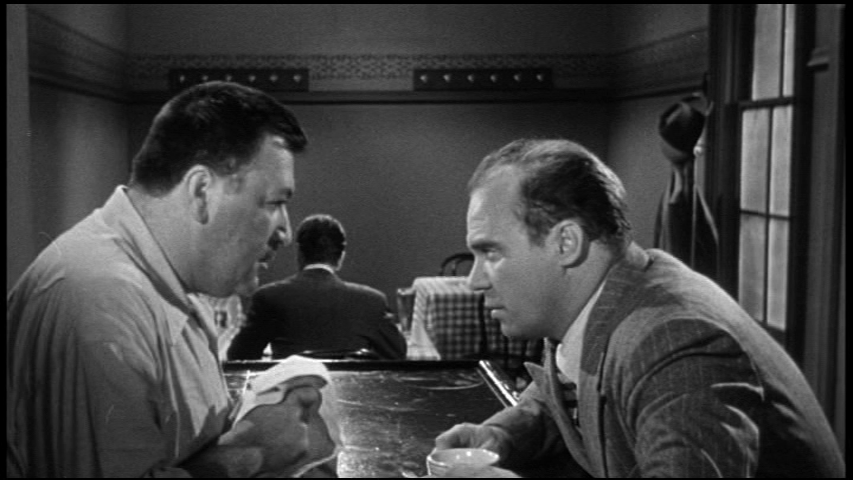
Ann Bancroft looked wonderful. I say this because the last time I saw her was in DON'T BOTHER TO KNOCK, where the costumes were eating her alive. In this one she looked very stylish. She was also cast much better.
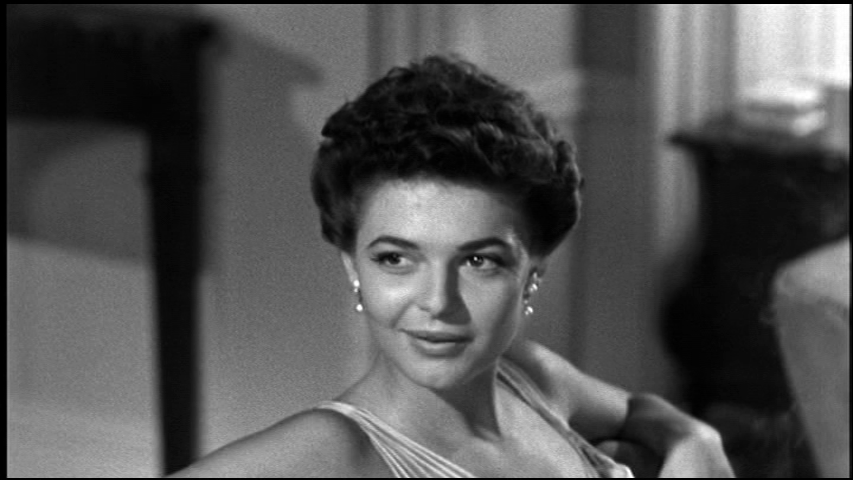
So, why was the photography so dull? Was this a B movie, with no budget for more expensive work? (Only a few moments looked really good, like below)
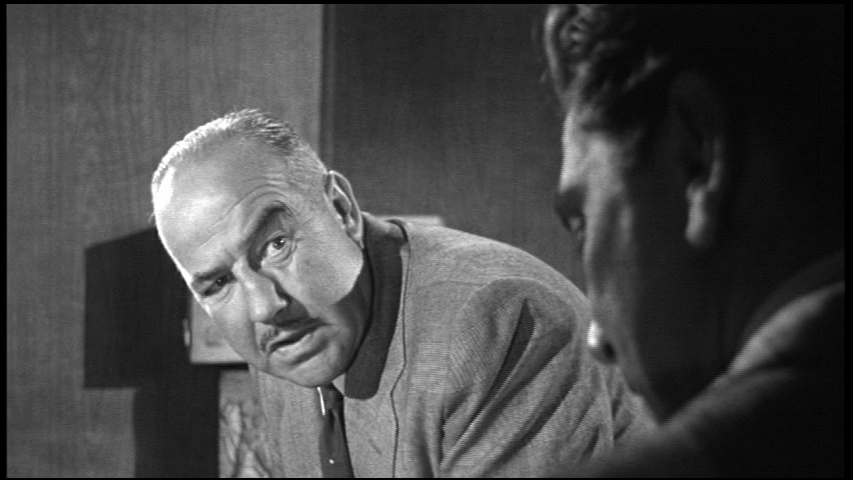
I'm surprised that several significant moments were lit so flatly. Even the big fights in the dark were done with very little detail and contrast.
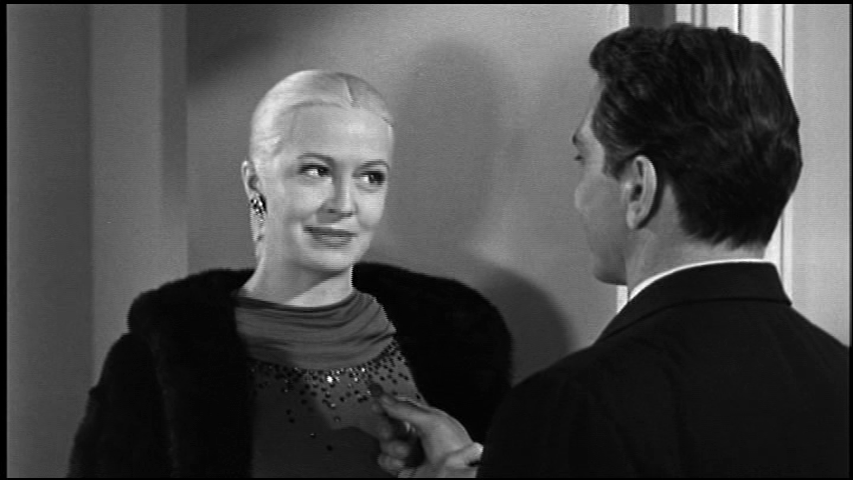
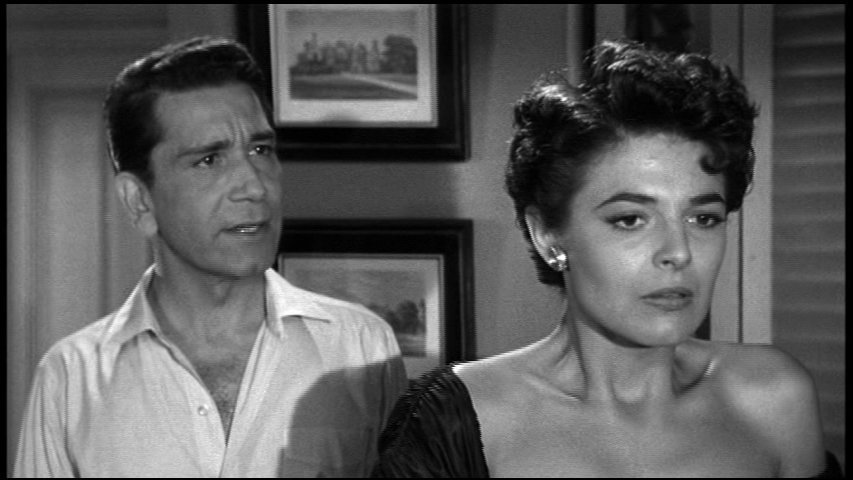
Speaking as an ex-Cameraman here......
I've not seen NEW YORK CONFIDENTIAL, though I have it on DVD and will take a look at it eventually. These frame clips---and, therefore, the DVD transfer from which they came---don't appear to be off an original camera negative. They seem "soft".
Ed ("Eddie") Fitzgerald, the cameraman---a name I know only vaguely---began in the business in 1931 and ended with his death in 1966. In his first 22 years he was a camera operator---working at MGM, and for Selznick, Hitchcock, John Ford, and others, on many fine films including DANCING LADY, SINCE YOU WENT AWAY, DUEL IN THE SUN, FORT APACHE, THE PARADINE CASE, THREE GODFATHERS, ROPE, 711 OCEAN DRIVE and more. In 1953 he began shooting independently---now as a Director of Photography---on mostly low-budget features and television series.
NEW YORK CONFIDENTIAL was a low-budget feature of the type Hollywood independents ground out regularly in the 1950s to fill the top half of a double-bill. I would say the shooting time was 21 days or less. The film was shot on Eastman Tri-X film, a very fast, but grainy, film mostly used for newsreels then, which the producers claimed was selected so that they could capture New York location scenes at night. That may well be true, but I would also add that Tri-X made it possible to use less lights and save bundles of budget money and the unsophisticated audience wouldn't be the wiser. It was extremely rare for a major Hollywood studio with resources to revert to Tri-X film on their major B&W features. They were interested in sleek, non-grainy, full grey-scale images for their product. Tri-X was a very high-contrast film, with a not-very-even grey scale.
From the illustrated images for NEW YORK CONFIDENTIAL (and I reiterate that I haven't seen the film), it appears that Mr. Fitzgerald was not watching carefully and learning when, in his early years, he worked with such legendary Directors of Photography as Franz Planer, Lee Garmes, George Barnes, Harold Rosson, Ray Rennahan, Joseph Valentine, Winton Hoch, and Stanley Cortez, among others.
The lighting in CONFIDENTIAL, while not flat by lighting standards, is often mispositioned on the performers and backgrounds. It looks like a job that had to be done by someone very quickly, but also by someone who couldn't do it quickly AND creatively. By most cameramen's thinking in those days, these kinds of B&W dramas (.....nobody had ever heard of noir then) were the easiest kinds of pictures to light; they were a piece of "cake"! There were standard lighting techniques common to all the cameramen and studios and if you followed them---any film of this type could look great. (In contrast, the "hardest" kind of B&W film to light was the romantic comedy or drama in which all the major players were stars who had to look great in every scene, in every shot, in close-up or moving around the room. Often, in a medium shot with three stars, each star was lit separately and so finitely that if one moved into the other's lighting zone even slightly, by accident, the whole lighting pattern would fall apart, and everyone would start to look bad!)
Fitzgerald's photography, while not "flat," is limited by the number of lighting units he has used. My calculation is this: Frame Clip #1 uses 8 lights, frame 2 uses 5 lights, and frames 3-5 use 4 lights each. This is pretty minimal lighting for shots like this, but it allows the company to move fast in its schedule. As I said before, I wish he had positioned some of the lights and flagged and gobo-ed them off more creatively. He would have given the picture a more classy and dramatic look. But what the heck, it was a cheapy, made to get into and out of the market quickly.
FWIW, just as a cameraman, my favorite shots for their lighting are in this order: A = frame clip 2, B = frame clip 1, C = frame clip 5, D = frame clip 3, E = frame clip 4. How do these compare with YOUR choices???
 |
|
|
|
|
|
|
|
|
|
|
|
|
|
 |
 |
 |
Posted: |
Jul 23, 2013 - 2:40 PM
|
|
|
|
By: |
manderley
(Member)
|
.....With regard to frame 2, it's my favorite as well because it's a portrait. It is of course standard practice to blur the background in a close-up / portrait. I would not blur the background. After focusing on the eyes I would try to keep background as sharp as is possible. But that's a quirk of mine.....
Don't you think the focus in a close-up's background is a function of the drama of the scene being played out?
Let's assume for a moment a scene between two people. I will give you two examples. In each scene the placements of the two principals and the shot sizes of the two principals are identical.
In the first scene, two people are sitting at a desk. They are talking to each other about tax preparation.  The master shot is the master shot and normally sharp, we see it in the beginning of the sequence but never come back to it. In each of the two close-ups, the background might be slightly soft or totally sharp, depending on your creative choice. They are not talking intimately, they are public in their attitudes. The master shot is the master shot and normally sharp, we see it in the beginning of the sequence but never come back to it. In each of the two close-ups, the background might be slightly soft or totally sharp, depending on your creative choice. They are not talking intimately, they are public in their attitudes.
In the second scene, two people are sitting at a table in a restaurant. They are talking to each other about romantic things between them. The master shot is the master shot and normally sharp, and we also see this at the beginning of the sequence, but never come back to it. In each of the two close-ups, however, the background is shot out-of-focus to point out the intimacy of the moment between just the two of them. Even in public, these two are essentially alone in their world, apart from others and oblivious to what's happening in the background and all around them.
Motion picture photography can create this kind of drama simply with mechanics, aided by the creative eye and the sense of story on the part of the cameraman. Some times it happens, often it doesn't.
 |
|
|
|
|
|
|
|
|
|
 |
 |
 |
Posted: |
Jul 23, 2013 - 4:51 PM
|
|
|
|
By: |
manderley
(Member)
|
Where do you suppose the lights are positioned? The artificial light coming in from the window is obvious. Key lights 1 and 2 have a wide spread and are positioned in front of and overhead the actors.You see see the spill from lights 3, 4 and 5 against the back and side walls. But still, this diagram isn't quite right. How would you fix it, Manderley?

From the camera position......
(Looking at this shot again, I have added several lights. And, for proper reference, these are my numbers, not yours.)
Foreground Duo:
1- Left man's key is a back-cross rim light coming from the upper grid behind the right man's back. It is a fresnel-type spot, probably a 2K, acting as the key on the left man and the backlight-rim on the right man with not as wide a spread as you imagine. The backlight has been scrimmed off the right man's suit back at about the upper back level.
2 - Right man's rim/key is positioned exactly opposite to the left. These are typical back cross-lighting patterns.
3- In the front, instead of going with a simple fill light ideally above the camera lens, and letting the rims be the keys, the DP has added another key light to the man on the right, from the upper left of the front of the shot. This puts the slight over-exposure on the back neck and side of the face of the man on the left because, although it is primarily lighting the man on the right, it has not been scrimmed fully off the man on the left. (The side of his face and his upper white shirt back should have been shadowed). You can see the effect and direction of this light because it creates a dark shadow under the arm of the right man and the whole shot hasn't been filled with light, instead.....
4- The cameraman has added a localized fill light from the right side of the camera to give some fill light in the shadow side of the face and arm of the man on the left. (The front side of his face looks in proper balance, but the side of his head, from the ear back is too hot. That's caused by light #3 on the right man which hasn't been shadowed off the left man.
Note that the added full key on the man on the right fills his face much more cleanly than the rugged-character look of the bartender. Man on right looks slicker and was obviously paid more money and got better billing than the man on left! 
Background......
All likely lit from the upper "greens" around the edge of the set.....
5- Light placed at the top of left wall, seated toward the back of the grid, and putting an atmospheric glow on the right wall as well as back rimming the coat and coat rack against the wall.
6- Light placed on upper grid a few feet into the set from back wall, pointed back, and giving soft glow on back wall.
7- Light placed on top of right wall, putting atmospheric glow on left wall.
8- Light placed on top of back wall, pointing down and into the set, and backlighting/rimming man seated at table, and tops and side edges of tables. You can see the bad flare effect coming from this light on the bar top where they have tried to dull it down with spray but haven't eliminated it.
9 - Very soft fill light likely coming from above right wall-front side of set, aimed down and filling suitback of seated man and checkered tablecloths.
10 - Light coming in window.
Charles Lang (SOME LIKE IT HOT, THE UNINVITED) would do this same shot and it would look spectacular, this example is acceptable if not exciting.
I hope that explains it---and that I haven't gotten my "rights" and "lefts" mixed up. I could show you on a set in 2 minutes---on paper it gets complicated!!! 
 |
|
|
|
|
|
|
|
|
|
|
|
|
|
|
|
|
|
|
|
|
|
 |
 |
 |
Posted: |
Jul 24, 2013 - 1:43 AM
|
|
|
|
By: |
Richard-W
(Member)
|
.....I think I can diagram the set-up you describe, but it may take a couple of days.....
Manderley:
There's really no need to diagram this set-up unless you feel a personal need. I'm not going to shoot it, you're not going to shoot it, and most of the people on this board are otherwise occupied with getting the musical score done!
Who says I'm not going to shoot it? Actually I have a pending shoot with a set-up almost exactly like this.
Yeah I talking about the score is okay but I enjoy talking shop a lot more. Camera and lighting set-ups are shop. Editing is shop. Talking about the score is just shooting the breeze.
Most lighting diagrams, however, are indicated best via a top-down, birds-eye view where you can actually see the placement of the lamp, subject, and camera symbols laid out on the stage floor.
That's the kind of diagram I'm referring to. Actually I do them routinely as part of my preparation.
You've seen CHINATOWN (1974)? In an AFI interview, Stanley Cortez sounded very proud of the way he lit Faye Dunaway, particularly in that scene where she meets Jack Nicholson in the Brown Derby. He said to compare how she is lit in the Brown Derby to the way "that other cameraman" lit her. "It's an entirely different woman," he said. He didn't specify technically what makes his lighting of Faye different from John Alonzo's. But he's right, it's a very different kind of lighting, more flattering, more glamorous. If I can find some frame grabs on the net maybe we can analyze that, and perhaps the set-ups in some other films, here.
 |
|
|
|
|
|
 |
A May 1954 news item in the Hollywood Reporter announced that NEW YORK CONFIDENTIAL would be partially shot in the new Eastman Tri-X film, which required no special lighting for night shooting. Perhaps that partially accounts for the lack of contrast in the film.
Wow, Bob, you are always full of fascinating background for us. Thanks.
The commentary track noted that this was a lower-budget film, perhaps accounting for the lack of dazzling photography.
|
|
|
|
|
 |
He didn't specify technically what makes his lighting of Faye different from John Alonzo's. But he's right, it's a very different kind of lighting, more flattering, more glamorous. If I can find some frame grabs on the net maybe we can analyze that, and perhaps the set-ups in some other films, here.
This sounds like a great reason to look at this movie again.
|
|
|
 |
 |
 |
|
|
 |
 |
 |
| |
|
|
|
 |
|
 |
|
|
|


